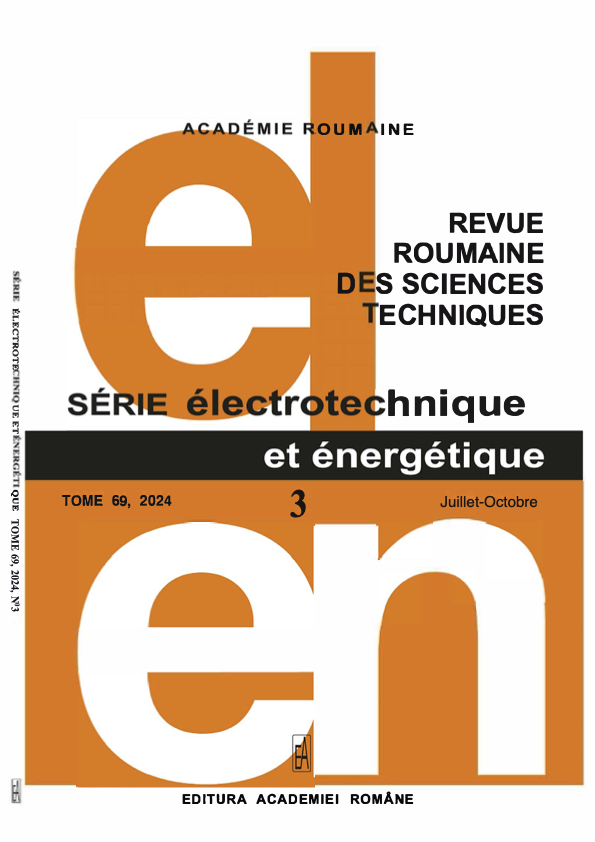INTELLIGENT FAULT DETECTION AND LOCATION IN ELECTRICAL HIGH-VOLTAGE TRANSMISSION LINES
DOI:
https://doi.org/10.59277/RRST-EE.2024.69.3.2Keywords:
Machine Learning, Fault location, Optimization, Atom search optimization, Transmission linesAbstract
Fault location in transmission lines is critical to ensure power systems' reliable and efficient operation. Accurate fault detection and localization are essential to minimize downtime, prevent cascading failures, and maintain the overall stability of the electrical grid. Over the years, various fault location methods have been proposed, ranging from traditional model-based approaches to more sophisticated artificial intelligence techniques. This research presents two fault location methodologies: the Atom search optimization metaheuristic approach (ASO) and machine learning (ML) with cubic spline models. We evaluate the performance of both approaches by considering different fault types, fault distances, and fault resistance. We analyze accuracy and computational efficiency. The findings reveal that the Metaheuristic Approach demonstrates robustness in fault detection and localization under diverse conditions but may suffer from higher computational overhead. In contrast, the hybridization of machine learning and metaheuristic exhibits promising potential in achieving real-time fault localization with improved accuracy.
References
(1) A.S. Ahmed, M.A. Attia, N.M. Hamed, A.Y. Abdelaziz, Modern optimization algorithms for fault location estimation in power systems, Engineering Science and Technology, an International Journal, 20, pp. 1475–1485 (2017).
(2) J. Ezquerra, V. Valverde, A.J. Mazon, I. Zamora and J.J. Zamora, Field programmable gate array implementation of a fault location system in transmission lines based on artificial neural networks, IET Generation, Transmission & Distribution, 5, 2, pp. 191–198 (2011).
(3) C.E.M. Pereira, L.C. Zanetta, Fault location in transmission lines using one-terminal postfault voltage data, IEEE Transactions Power Delivery, 19, pp. 570–575 (2004).
(4) L. Wei, W. Guo, F. Wen, G. Ledwich, Z. Liao, J. Xin, Waveform Matching Approach for Fault Diagnosis of a High-Voltage Transmission Line Employing Harmony Search Algorithm, IET Generation, Transmission & Distribution, 4, pp. 801–809 (2010).
(5) M. Kezunovic, S. Lou, Z. Galijasevic, D. Ristanovic, Accurate fault location in transmission networks using modeling, simulation and limited field recorded data, Power Systems Engineering Research Center, pp. 1–50 (2002).
(6) R. Rohani, A. Koochaki, J. Siahbalaee, Fault location in VSC-HVDC systems based on NSGA-II and discrete wavelet transform, International Journal of Renewable Energy Research, 12, 3, pp. 1347–1361 (2022).
(7) S. G. Di Santo, A.D.R. Albertini, R.R. Tiferes, Optimization-Based Fault Location Algorithm for Series-Compensated Power Transmission Lines, IEEE Access, 10, pp. 46864–46877 (2022).
(8) H. Gupta, P. Kumar, S. Saurabh, S.K. Mishra, B. Appasani, A. Pati, C. Ravariu, A. Srinivasulu, Category boosting machine learning algorithm for breast cancer prediction, Rev. Roum. Sci. Techn. – Électrotechn. et Énerg, 66, 3, pp. 201–206 (2021).
(9) F. Rafique, L. Fu, M.H.U. Haq, R. Mai, Automatic features extraction by transfer learning for transmission line protection, Rev. Roum. Sci. Techn– Électrotechn. et Énerg. 68, 3, pp. 339–344 (2023).
(10) B. Ponnuswamy, C. Columbus, S.R. Lakshmi, J. Chithambaram, Wind turbine fault modeling and classification using cuckoo-optimized modular neural networks, Rev. Roum. Sci. Techn.– Électrotechn. et Énerg, 68, 4, pp. 369–374, (2023).
(11) B.R.C. Joseph, I.J. Jebadurai, G.J.L. Paulraj, J. Jebadurai, Mulli mary varuveL deep vein net: deep vein thrombosis identification via sooty tern optimized deep learning network, Rev. Roum. Sci. Techn.–Électrotechn. et Énerg., 69, 1, pp. 115–120, Bucarest, 2024.
(12) N. Sabri, A. Tlemçani, A. Chouder, Real-time diagnosis of battery cells for stand-alone photovoltaic system using machine learning techniques, Rev. Roum. Sci. Techn.–Électrotechn. et Énerg., 66, 2, pp. 105–110, Bucarest, 2021.
(13) J. Liang, Tao. Xiaojie, Fu. Yang, Fu. Yong, Mi. Yang, Li. Zhenkun, A new single ended fault location method for transmission line based on positive sequence superimposed network during auto-reclosing, IEEE Transactions on Power Delivery, 34, 3, pp.1019-1029 (2019).
(14) Z. Weigu, W. Liying, Z. Zhenxing, Atom search optimization and its application to solve a hydrogeologic parameter estimation problem, Knowledge-Based Systems, 163, 1, pp. 283–304 (2019).
(15) L. Roach, G.M. Rignanese, A. Erriguible, C. Aymonier, Applications of machine learning in supercritical fluids research, The Journal of Supercritical Fluids, 202, pp. 1–28 (2023).
(16) M.G. Davoudi, J. Sadeh, E. Kamyab, Time domain fault location on transmission lines using genetic algorithm, 11th International Conference on Environment and Electrical Engineering IEEE, Venice, Italy, pp. 1–6, 18-25 May 2012.
Downloads
Published
Issue
Section
License
Copyright (c) 2024 REVUE ROUMAINE DES SCIENCES TECHNIQUES — SÉRIE ÉLECTROTECHNIQUE ET ÉNERGÉTIQUE

This work is licensed under a Creative Commons Attribution-NonCommercial-NoDerivatives 4.0 International License.


